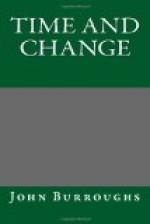It seems to me that evolution adds greatly to the wonder of life, because it takes it out of the realm of the arbitrary, the exceptional, and links it to the sequence of natural causation. That man should have been brought into existence by the fiat of an omnipotent power is less an occasion for wonder than that he should have worked his way up from the lower non-human forms. That the manward impulse should never have been lost in all the appalling vicissitudes of geologic time, that it should have pushed steadily on, through mollusk and fish and amphibian and reptile, through swimming and creeping and climbing things, and that the forms that conveyed it should have escaped the devouring monsters of the earth, sea, and air till it came to its full estate in a human being, is the wonder of wonders.
In like manner, evolution raises immensely the value of the biological processes that are everywhere operative about us, by showing us that these processes are the channels through which the creative energy has worked, and is still working. Not in the far-off or in the exceptional does it seek the key to man’s origin, but in the sleepless activity of the creative force, which has been pushing onward and upward, from the remotest time, till it has come to full fruition in man.
It is easy to inject into man’s natural history a supernatural element, as nearly all biologists and anthropologists before Darwin’s time did, and as many serious people still do. It is too easy, in fact, and the temptation to do so is great. It makes short work of the problem of man’s origin, and saves a deal of trouble. But this method is more and more discredited, and the younger biologists and natural philosophers accept the zoological conception of man, which links him with all the lower forms, and proceed to work from that.
When we have taken the first step in trying to solve the problem of man’s origin, where can we stop? Can we find any point in his history where we can say, Here his natural history ends, and his supernatural history begins? Does his natural history end with the pre-glacial man, with the cave man, or the river-drift man, with the low-browed, long-jawed fossil man of Java,—Pithecanthropus erectus, described by Du Bois? Where shall we stop on his trail? I had almost said “step on his tail,” for we undoubtedly, if we go back far enough, come to a time when man had a tail. Every unborn child at a certain stage of its development still has a tail, as it also has a coat of hair and a hand-like foot. But could we stop with the tailed man—the manlike ape, or the apelike man? Did his Creator start him with this appendage, or was it a later suffix of his own invention?
If we once seriously undertake to solve the riddle of man’s origin, and go back along the line of his descent, I doubt if we can find the point, or the form, where the natural is supplanted by the supernatural as it is called, where causation ends and miracle begins. Even the first dawn of protozoic life in the primordial seas must have been natural, or it would not have occurred,—must have been potential in what went before it. In this universe, so far as we know it, one thing springs from another; the sequence of cause and effect is continuous and inviolable.




